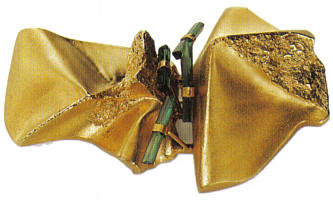The mound where the tomb is located
The construction of the tomb was described by historian Sima Qian (145–90 BCE) in his most noted work Shiji, written a century after the mausoleum's completion. Work on the mausoleum began in 246 BCE soon after Emperor Qin (then aged 13) ascended the throne, and the project eventually involved 700,000 workers. Geographer Li Daoyuan, writing six centuries after the first emperor's death, recorded in Shui Jing Zhu that Mount Li was a favoured location due to its auspicious geology, "famed for its jade mines, its northern side was rich in gold, and its southern side rich in beautiful jade; the first emperor, covetous of its fine reputation, therefore chose to be buried there". Sima Qian wrote that the first emperor was buried with palaces, towers, officials, valuable artifacts and wondrous objects. According to this account, 100 flowing rivers were simulated using mercury, and above them the ceiling was decorated with heavenly bodies below which were the features of the land. Some translations of this passage refer to "models" or "imitations"; however, those words were not used in the original text, which makes no mention of the terracotta army. High levels of mercury were found in the soil of the tomb mound, giving credence to Sima Qian's account. Later historical accounts suggested that the complex and tomb itself had been looted by Xiang Yu, a contender for the throne after the death of the first emperor. However, there are indications that the tomb itself may not have been plundered.
Discovery
The Terracotta Army was discovered on 29 March 1974 by farmers digging a water well approximately 1.5 kilometres (0.93 mi) east of the Qin Emperor's tomb mound at Mount Li (Lishan), a region riddled with underground springs and watercourses. For centuries, occasional reports mentioned pieces of terracotta figures and fragments of the Qin necropolis – roofing tiles, bricks and chunks of masonry. This discovery prompted Chinese archaeologists, including Zhao Kangmin, to investigate, revealing the largest pottery figurine group ever found. A museum complex has since been constructed over the area, the largest pit being enclosed by a roofed structure.
Necropolis
View of the Terracotta Army
Mausoleum of the First Qin Emperor, Hall 1
The Terracotta Army is part of a much larger necropolis. Ground-penetrating radar and core sampling have measured the area to be approximately 98 square kilometers (38 square miles).
The necropolis was constructed as a microcosm of the emperor's imperial palace or compound, and covers a large area around the tomb mound of the first emperor. The earthen tomb mound is located at the foot of Mount Li and built in a pyramidal shape, and is surrounded by two solidly built rammed earth walls with gateway entrances. The necropolis consists of several offices, halls, stables, other structures as well as an imperial park placed around the tomb mound.
The warriors stand guard to the east of the tomb. Up to 5 metres (16 ft) of reddish, sandy soil had accumulated over the site in the two millennia following its construction, but archaeologists found evidence of earlier disturbances at the site. During the excavations near the Mount Li burial mound, archaeologists found several graves dating from the eighteenth and nineteenth centuries, where diggers had apparently struck terracotta fragments. These were discarded as worthless and used along with soil to back fill the excavations.
Tomb
Main article: Mausoleum of the First Qin Emperor
The tomb appears to be a hermetically sealed space roughly the size of a football pitch (c. 100 × 75 m). The tomb remains unopened, possibly due to concerns over preservation of its artifacts. For example, after the excavation of the Terracotta Army, the painted surface present on some terracotta figures began to flake and fade. The lacquer covering the paint can curl in fifteen seconds once exposed to Xi'an's dry air and can flake off in just four minutes.

No comments:
Post a Comment